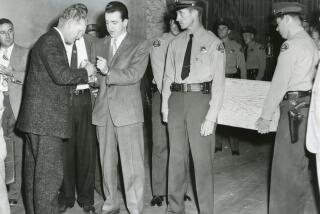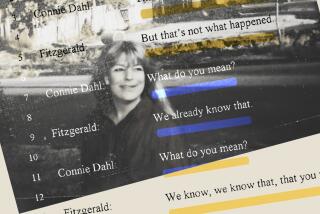FURTHER DEFENSE OF ‘A DEED OF DEATH’
- Share via
Sidney Kirkpatrick’s glib response (Book Review, Aug. 19) to the charge of three major mistakes in his review of my book about the 1922 William Desmond Taylor case, “A Deed of Death,” in no way answers the charge.
Unable to explain how he (1) mistook the date of the murder, (2) confused Mary Miles Minter’s mother with her grandmother and (3) overlooked my book’s account (based on police records) of Minter’s last visit to Taylor two nights before the murder, what does he say? Nothing.
Instead, his defense is to quote selectively from a belated report, written in 1941 by Det. Leroy Sanderson in an unsuccessful attempt to reopen the case 21 years after the murder. This untrustworthy report, not in my book, serves as the bedrock of Kirkpatrick’s “A Cast of Killers,” where it appears not as he quotes it in The Times but, like so much of his book, as semi-fictional dialogue.
No one but Sanderson and Kirkpatrick thinks “it is reasonable to assume” Minter was at Taylor’s the night of the murder on the basis of the mother’s 7 p.m. phone call to her tax accountant, inquiring after Minter’s whereabouts, about which the accountant knew nothing. Police records show that at that hour Minter and her sister were at their grandmother’s, where they stayed the night. Sanderson and Kirkpatrick may believe the mother “never told the truth as to her (the mother’s) whereabouts” that night, but the district attorney and the grand jury heard the testimony of two witnesses who from 7 to 9 p.m. were the mother’s guests, providing her alibi, since Taylor was murdered at 8 p.m.
As for Minter’s statement that “her mother said she had killed Taylor,” this was at the height of their fighting and lawsuits over money. Minter repeatedly asserted, until her death in 1984, that her mother didn’t kill Taylor. King Vidor told me he abandoned his book (I had urged him to write about the Taylor case) because he could not prove the mother was the murderer.
She was never indicted because the police decided there was no evidence against her, which Sanderson confirms in his report’s conclusion, omitted by Kirkpatrick: “There is very little physical evidence available.” No wonder Sanderson’s attempt to reopen the case failed. Evidence that this was an early drugs case, that Taylor was fighting the pushers to rescue addict Mabel Normand, with whom he was in love, and that he was killed by a hit man forms the substance of my book, “A Deed of Death.”
ROBERT GIROUX
Farrar, Straus & Giroux
NEW YORK
More to Read
Sign up for our Book Club newsletter
Get the latest news, events and more from the Los Angeles Times Book Club, and help us get L.A. reading and talking.
You may occasionally receive promotional content from the Los Angeles Times.








